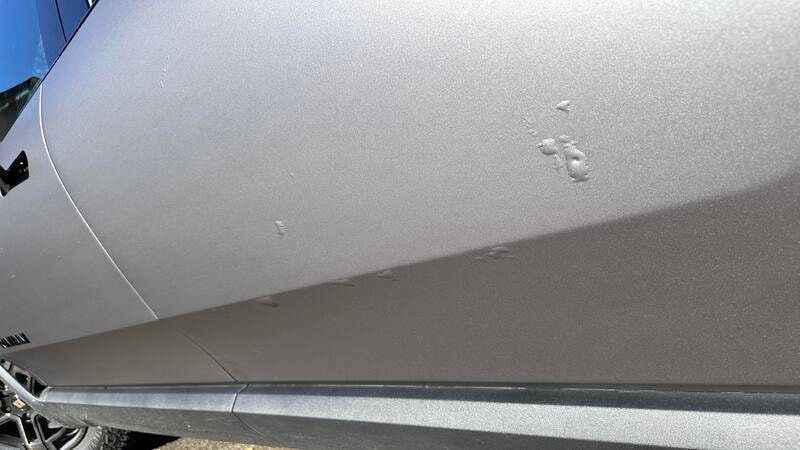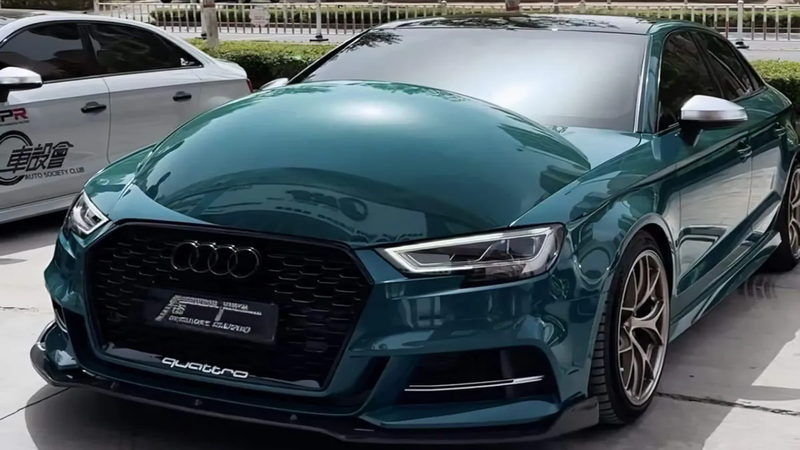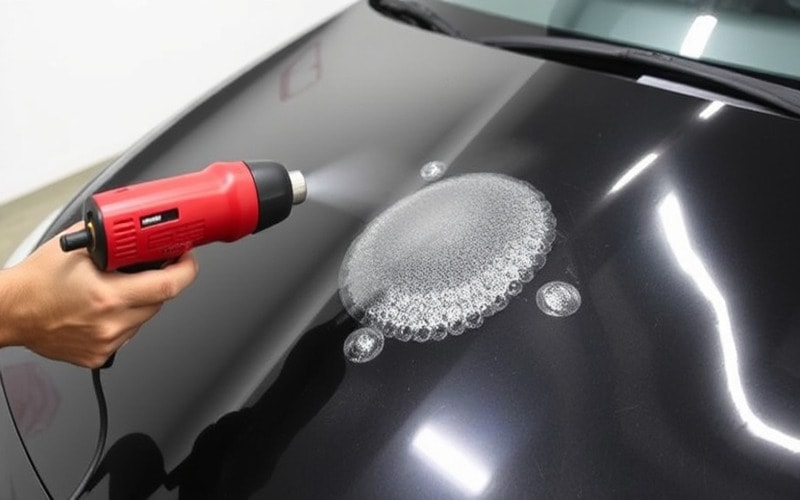Vinyl wraps transform your car—until bubbles ruin the look! Discover why bubbles form, how to prevent them, and professional removal techniques. Avoid common mistakes and learn advanced care tips to keep your wrap flawless. Get ready for showroom-worthy perfection!
Understanding Vinyl Wrap and Air Bubbles
Vinyl wraps are the most popular solution among car enthusiasts for upgrading their car’s style. These wraps combine style and protection for your vehicle. Moreover, vinyl wraps come in unlimited customization options as they come in various finishes and colors. You can choose a color, whether light or dark, and finish (glossy, matte, or satin), whichever suits you the best.
Vinyl wraps create a protective barrier against the outer environment. It efficiently protects your car’s paint from scratches, road debris, and UV damage, thus keeping it looking fresh and new.

However, one common issue with vinyl wraps is the formation of air bubbles after installation. If the installer does not master the wrapping techniques, these bubbles emerge when air becomes trapped between the wrap and the car’s surface.
Small bubbles are very simple to remove with tools like squeegees or heat guns, but larger ones require more complicated procedures and even professional assistance.
Understanding the root cause of air bubbles is essential for a smooth application. Knowing the reason behind bubbles is also an important factor in fixing them. The most common problem is dirt or dust on the surface of the car. This dust could hinder effective adherence. Moreover, excessive heat during installation can cause the vinyl to stretch and trap air.

Furthermore, improper techniques, such as uneven pressure or faulty alignment, can contribute to bubble formation. A properly prepped surface and careful installation can significantly decrease the possibility of this type of issue.
The Problem with Bubbles in Vinyl Car Wraps
Air bubbles in vinyl car wrap not only reduce the vehicle’s aesthetic appeal but can also compromise the wrap’s durability. These problems are generally caused by trapped air during installation, inadequate surface preparation, or temperature variations. Here are some important factors that cause bubbles in vinyl car wraps.

Installation Temperature
The installation of the wrap has to be done in good condition, as even slight variations in temperature can cause issues.
For example, putting a wrap in a cold climate can reduce the adhesive’s effectiveness, but too much heat can lead to overstretching and bubble formation.
Surface Cleanliness
Another important factor is surface problems. If the surface is not properly cleaned before the application, the impurities can prevent the vinyl from adhering to the car surface properly. Even the slightest bit of grease or dust can cause weak points where air gets trapped to form bubbles.
Durability Issues
Air bubbles create an impact that goes well beyond aesthetic disturbance. Over time, trapped air can expand, particularly in high-temperature environments, causing the wrap to lift or peel. This not only shortens the lifespan of the wrap but also exposes the car’s paint to potential harm.

Preventing Vinyl Wrap Bubbles
You can easily prevent the formation of air bubbles under your vinyl wraps by following some common preventative techniques.
Surface Cleaning and Drying
The first step in preventing bubbles in vinyl wraps is proper surface preparation. Before applying the wrap, make sure the car’s surface is washed properly to eliminate any dirt, grease, and debris. Even the smallest particles can form air pockets during installation. Always use a high-quality cleaning solution that is safe for automobile finishes.
Moreover, thoroughly dry the surface to avoid moisture trapping under the wrap. It is ideal to use a microfiber cloth or towel to pat dry the surface. After pat drying, it is best to leave the car to air dry for a while to achieve the best results. However, ensure you dry the car in a clean and closed space to avoid any dirt or debris.

Applying Consistent Pressure
When applying the wrap, use uniform pressure. To push air to the edges, work carefully from the center of the surface outward using a squeegee. This approach prevents air from becoming trapped in the middle.
Avoid stretching the vinyl wrap too much, as this can result in weak regions where air pockets can form easily. Stretching also impacts the material’s adherence, increasing the possibility of bubble formation over time.

Invest in High-Quality Wrap
It is always best to invest in high-quality car wraps, such as Carlike’s high-class vinyl wraps, especially if you are dealing with high-end vehicles. High-quality vinyl wraps incorporate bubble-reducing technology, such as air-release channels. Investing in these wraps can greatly reduce the probability of bubbles during application, so it is a worthwhile investment for your car.
Installation Environment
Finally, applying the wrap in a controlled setting with moderate temperature and humidity could lead to improved outcomes. Harsh weather conditions can damage the vinyl’s adhesive characteristics.
Addressing bubbles during the installation process is critical for maintaining both visual attractiveness and practical durability. Working in a controlled atmosphere, using high-quality tools, and adhering to manufacturer specifications can help reduce the risk of bubbles and extend the life of the wrap.

Removing Vinyl Wrap Bubbles
If by any chance, even after following meticulous application procedures, you encounter an air bubble, then do not worry, as we will teach you how to remove them effectively.
- Firstly, you have to be very patient while removing vinyl wrap bubbles, so calm your nerves before you take on this project.
- The second most important thing is having the right tools for the job. A heat gun is a useful tool for softening the vinyl, thus allowing trapped air to escape. However, it is critical to use low heat and keep a safe distance to avoid destroying the vinyl.
- A squeegee can be used to gently and consistently push small air bubbles toward the wrap’s edges. Move slowly and in small portions to avoid wrinkles and extra bubbles.

- For persistent, tiny bubbles, slowly pierce the bubble to release the air. Make sure the pin is small to avoid noticeable holes in the wrap.
- In any case, do not use harsh chemicals or rough tools to remove bubbles. Or you can end up damaging the vinyl’s surface or adhesive.
- Address air bubbles as soon as they appear because extended exposure to heat or environmental factors can cause them to expand and become more difficult to remove.
Common Mistakes to Avoid When Removing Bubbles

Removing air bubbles from vinyl wraps requires precision, care, and flawless technique. There are many things that can go wrong while trying to make the vinyl surface perfect again. Even a minor error can result in catastrophic results, rendering the entire wrap useless. Here are some common mistakes to avoid when removing air bubbles from vinyl wraps.
One common mistake is applying too much pressure while pushing out the bubble with a squeegee or your hands. Excessive pressure can cause stretching and tearing of the vinyl. It can also force the bubble further under the wrap, making it more difficult to remove. Instead, use a steady, moderate push to gently direct the air to the edges.
Another problem is keeping the heat gun too close to the vinyl. High heat or prolonged exposure can melt or deform the material, resulting in an unattractive scar. Excessive heat can also cause adhesion failure. Use the heat gun at a safe distance and keep it moving to ensure even heat distribution.

Using a large pin can result in complications. While pricking bubbles is useful for small air pockets, a large pin might cause a visible hole in the wrap, decreasing its aesthetic value. Use a very fine, tiny pin or needle and puncture the bubble with care.
Another mistake is to ignore microscopic air bubbles. These can grow over time as heat and other conditions expand the trapped air, transforming a minor issue into a major one. Finally, using the improper sort of squeegee, particularly one with harsh or rough edges, can harm the vinyl. Always use a soft rubber squeegee that is best suited for car wraps.
Maintaining Your Vinyl Wrap Car
Only with proper care and regular maintenance can you keep your vinyl wrap in its best condition for a longer duration.
The first step in maintaining your car wrap in good condition is to wash it on a regular basis. To remove dirt and grime without harming the surface, use a gentle, pH-balanced soap with a soft cloth or sponge. Avoid automatic car washes with stiff brushes, as they can peel or harm the wrap.

Waxing can also offer an extra layer of protection. You can use a wrap-safe wax or sealer to protect the wrap’s finish from dirt and UV radiation.
Moreover, avoid exposing your vehicle to extreme temperatures as well as prolonged direct sunlight, since these can cause the wrap to fade, bubble, and even break. Whenever feasible, park in a shaded place to avoid sun exposure.
It is extremely important to avoid using harsh chemicals or abrasive products when cleaning the car. To keep the wrap in good condition, use microfiber towels and vinyl-friendly cleaning products. Pollution and dust can build up over time, particularly in urban areas, so try to park away from construction zones or high-pollution areas whenever possible.

Lastly, for long-term protection, consider using a vinyl wrap sealant. Such products serve as a protective barrier against environmental factors, extending the wrap’s life. With regular care and attention, your vinyl wrap will maintain its visual appeal and utility for years to come.
Advanced Techniques for Vinyl Wrap Care
Cleaning and maintenance are required to keep a vinyl wrap in excellent condition. You can follow some of our advanced tips to enhance the appeal of your wrap by increasing durability.

Using a vinyl wrap-specific cleaning solution is an ideal way to remove dirt and debris while preserving the material. These products are designed to retain the wrap’s finish while preventing streaking or dulling.
After choosing the right color for your car wrap, it is essential to maintain the wonderful color. Applying a vinyl wrap sealer provides further protection from UV radiation, dirt, and weather elements. The sealer produces a protective coating, allowing the wrap to retain its color and preventing fading or splitting. Moreover, regular application can considerably increase the longevity of the wrap.
A heat gun is an extremely useful gadget for removing constant air bubbles or creases. Gently heating the vinyl helps to smooth out irregularities and ensures a tight fit around corners and edges. When using a heat gun, precision is essential to avoid overheating or melting the wrap.

If you want to add an extra layer of strength, try applying paint protection film. This clear layer protects the wrap from scratches, minor abrasions, and extreme weather, making it suitable for vehicles that go through rough use or extreme settings.
Finally, using a high-quality squeegee can have a considerable impact on application and upkeep. Soft-edged squeegees are meant to glide over the wrap without scratching, resulting in a smooth, bubble-free finish. These innovative techniques not only preserve the appearance of your vinyl wrap but also improve its durability and performance.
FAQs
Q1: Can air bubbles in vinyl wrap cause damage to my car’s paint?
Air bubbles do not normally damage your car’s paint, but if left untreated, they can expand due to heat and pressure, potentially causing the vinyl to peel or lift. This could allow dirt, moisture, or debris to get underneath, potentially damaging the paint over time.
Q2: How do I remove air bubbles from vinyl wrap without damaging the surface?
A. Use a heat gun to slowly heat the vinyl, making it more flexible and easier to work with. Then, using a soft rubber squeegee, apply light pressure to push the air bubbles toward the edge. You can also prick small bubbles with a fine pin or needle as it will release trapped air without harming the wrap. Avoid using too much force or sharp things that may scratch or tear the vinyl.
Q3: Can I use a hair dryer instead of a heat gun to remove air bubbles?
A. Yes, a hair dryer can replace a heat gun, especially for minor projects. While it does not provide the same amount of heat control, it does soften the vinyl enough to smooth out bubbles. Use the lowest heat setting and keep a safe distance to avoid overheating or harming the wrap.
Q4: Can I reuse vinyl wrap after removing air bubbles?
A. Reusing vinyl wrap is not normally recommended. When the adhesive backing is removed, it loses its effectiveness, and the material can expand or deform. If reapplication is required, use a new piece of vinyl to achieve a smooth and durable finish.
Conclusion
This guide explains bubble formation causes, prevention methods, and proper removal techniques. It outlines common bubble-removal mistakes and provides maintenance solutions. When bubbles persist despite repair attempts, consider replacing affected sections to maintain optimal appearance and material integrity. And severe bubbling indicates a necessary replacement for continued vehicle protection.
Keep Your Wrap Flawless – Get Pro-Grade Care Tips Now!
Protect your car’s shine effortlessly! Get flawless, long-lasting car protection with CARLIKE® premium vinyl wraps! Our high-quality films resist bubbles, scratches, and UV damage while our easy installation guides help you DIY like a pro. Enjoy self-healing technology and superior durability.
Contact us now for a free consultation! Get durable protection and pro installation tips!



